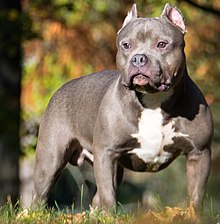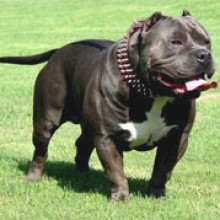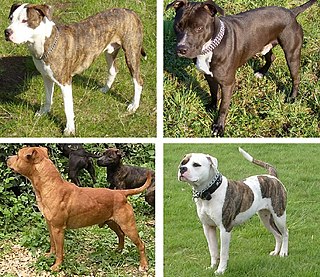
Pit bull is an umbrella term for several types of dog believed to have descended from bull and terriers. In the United States, the term is usually considered to include the American Pit Bull Terrier, American Staffordshire Terrier, American Bully, Staffordshire Bull Terrier, and sometimes the American Bulldog, along with any crossbred dog that shares certain physical characteristics with these breeds. In other countries, including the United Kingdom, the term is used as an abbreviation of the American Pit Bull Terrier breed specifically, while the Staffordshire Bull Terrier is not considered a pit bull. Most pit bull-type dogs descend from the British bull and terrier, a 19th-century dog-fighting type developed from crosses between the Old English Bulldog and the Old English Terrier.
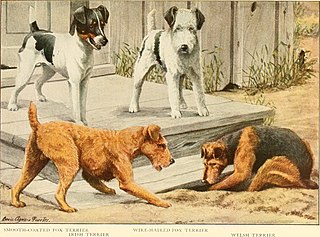
Terrier is a type of dog originally bred to hunt vermin. A terrier is a dog of any one of many breeds or landraces of the terrier type, which are typically small, wiry, game, and fearless. There are five different groups of terrier, with each group having different shapes and sizes.

The Bullmastiff is an English breed of dog of mastiff type and large size, with a solid build and a short muzzle. It was developed as a guard dog in the nineteenth century by cross-breeding the English Mastiff with the now-extinct Old English Bulldog. It was recognised as a breed by The Kennel Club in 1924.

The Bulldog is a British breed of dog of mastiff type. It may also be known as the English Bulldog or British Bulldog. It is a medium-sized, muscular dog of around 40–55 lb (18–25 kg). They have large heads with thick folds of skin around the face and shoulders and a relatively flat face with a protruding lower jaw. The breed has significant health issues as a consequence of breeding for its distinctive appearance, including brachycephaly, hip dysplasia, heat sensitivity, and skin infections. Due to concerns about their quality of life, breeding Bulldogs is illegal in Norway and the Netherlands.

The Staffordshire Bull Terrier, also called the Staffy or Stafford, is a purebred dog of small to medium size in the terrier group that originated in the northern parts of Birmingham and in the Black Country of Staffordshire, for which it is named. They descended from 19th-century bull terriers that were developed by crossing bulldogs with various terriers to create a generic type of dog generally known as bull and terriers. Staffords share the same ancestry with the modern Bull Terrier, although the two breeds developed along independent lines, and do not resemble each other. Modern Staffords more closely resemble the old type of bull terrier, and were first recognised as a purebred dog breed by The Kennel Club of Great Britain in 1935.

The Patterdale Terrier is a breed "type" of dog descended from the Northern terrier breeds of the early 18th century. Bred in Patterdale, Lake District.

The Boston Terrier is a breed of dog originating in the United States of America. This "American Gentleman" was accepted in 1893 by the American Kennel Club as a non-sporting breed. Boston Terriers are small and compact with a short tail and erect ears.

The American bulldog is a large, muscular breed of mastiff-type dog. Their ancestors were brought to the British North American colonies where they worked on small farms and ranches.
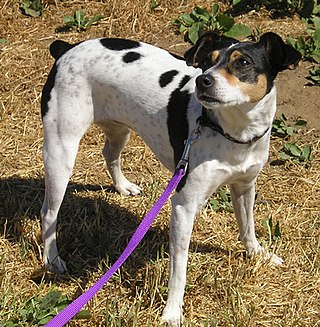
The Rat Terrier is an American dog breed with a background as a farm dog and hunting companion. They share much ancestry with the small hunting dogs known as feists. Common throughout family farms in the 1920s and 1930s, they are now recognized by the United (UKC) and American Kennel Clubs (AKC) and are considered a rare breed. Rat Terriers are an intelligent and active breed that can be kept both for pest control and as a family pet.

In law, breed-specific legislation (BSL) is a type of law that prohibits or restricts particular breeds or types of dog. Such laws range from outright bans on the possession of these dogs, to restrictions and conditions on ownership, and often establishes a legal presumption that such dogs are dangerous or vicious to prevent dog attacks. Some jurisdictions have enacted breed-specific legislation in response to a number of fatalities or maulings involving pit bull–type dogs or other dog breeds commonly used in dog fighting, and some government organizations such as the United States Army and Marine Corps have taken administrative action as well. Due to opposition to such laws in the United States, anti-BSL laws have been passed in 21 of the 50 state-level governments, prohibiting or restricting the ability of jurisdictions within those states to enact or enforce breed-specific legislation.
Toy dog traditionally refers to a very small dog or a grouping of small and very small breeds of dog. A toy dog may be of any of various dog types. Types of dogs referred to as toy dogs may include spaniels, pinschers and terriers that have been bred down in size. Not all toy dogs are lap dogs.

The Dangerous Dogs Act 1991 is an act of the Parliament of the United Kingdom prohibiting or restricting certain types of dogs and codifying the criminal offence of allowing a dog of any breed to be dangerously out of control. After a series of eleven dog attacks in 1991, Home Secretary Kenneth Baker promised "to rid the country of the menace of these fighting dogs". The Act has been controversial for failing to stem the rise of dog attacks and for focusing on a dog's breed or looks instead of an individual dog's behaviour.
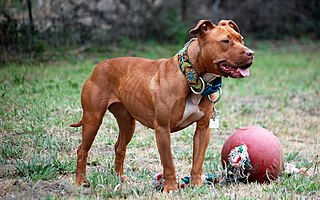
The American Pit Bull Terrier (APBT) is a dog breed recognized by the United Kennel Club (UKC) and the American Dog Breeders Association (ADBA), but not the American Kennel Club (AKC). It is a medium-sized, short-haired dog, of a solid build, whose early ancestors came from England. When compared with the English Staffordshire Bull Terrier, the American Pit Bull Terrier is larger by margins of 6–8 inches (15–20 cm) in height and 25–35 pounds (11–16 kg) in weight. The American Pit Bull Terrier varies in size: males are normally about 18–21 inches (45–53 cm) in height and around 35–60 pounds (15–27 kg) in weight, while females are normally around 17–20 inches (43–50 cm) in height and 30–50 pounds (13–22 kg) in weight.

The American Staffordshire Terrier, also known as the AmStaff, is a medium-sized, short-coated American dog breed recognized by the American Kennel Club, but not the United Kennel Club, which instead allows American Staffordshire Terriers to be registered under the American Pit Bull Terrier breed.

The Bull Terrier is a breed of dog in the terrier family. There is also a miniature version of this breed which is officially known as the Miniature Bull Terrier. This breed originates in 19th century England. Originally bred for vermin control and bloodsports, this breed can be independent and stubborn.

The Olde English Bulldogge is an American dog breed, recognized by the United Kennel Club (UKC) in January 2014. The breed is listed in the UKC Guardian Dog Group. Five years prior to UKC recognition, the breed was registered by the former Canine Developmental, Health and Performance Registry (CDHPR), a privately held business located in Kalamazoo, Michigan. In the early 2000s, CDHPR had been working with the UKC under a unique agreement to develop breeding plans and strategies in an effort to produce improved breeds of dogs that would be accepted as purebred and, therefore, eligible for UKC registration.

Bull and terrier was a common name for crossbreeds between bulldogs and terriers in the early 1800s. Other names included half-and-halfs and half-breds. It was a time in history when, for thousands of years, dogs were classified by use or function, unlike the modern pets of today that were bred to be conformation show dogs and family pets. Bull and terrier crosses were originally bred to function as fighting dogs for bull- and bear-baiting, and other popular blood sports during the Victorian era. The sport of bull baiting required a dog with attributes such as tenacity and courage, a wide frame with heavy bone, and a muscular, protruding jaw. By crossing bulldogs with various terriers from Ireland and Great Britain, breeders introduced "gameness and agility" into the hybrid mix.
The American Dog Breeders Association (ADBA) is an all-breed dog registry founded in 1909 by Guy McCord and Con Feeley. The registry is headquartered in Salt Lake City, UT in the U.S., but has multiple affiliate clubs located around the world. The registry began by promoting the John Colby strain of pit bull types. Over time, the focus changed to the registration and promotion of purebred American Pit Bull Terriers, a breed that few other breed registries have recognized because of its ancestral origins as a fighting dog in England and Ireland. The first official breed registry to recognize American Pit Bull Terriers was the United Kennel Club (UKC) in 1898 when it registered its first dog, "Bennett’s Ring", owned by UKC founder C. Z. Bennett. ADBA sponsors various conformation dog shows, weight pulling competitions, and Top Dog Athletic Events consisting of three canine competitions: treadmill race, wall climb and lure coursing. In 1976, ADBA began publishing a quarterly magazine titled The American Pit Bull Terrier Gazette.
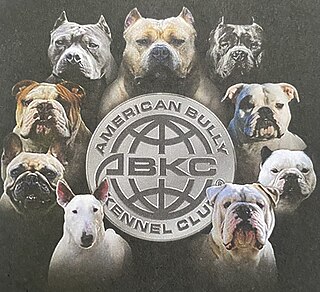
The American Bully Kennel Club (ABKC) is an international official registry for the American Bully breed. Created in 2004 to acknowledge and preserve the American Bully, the ABKC has played a role in creating breed standards and planning exhibitions. For breeders and aficionados, the ABKC offers pedigree information, registration services, and educational materials. The ABKC also inspects breeding facilities and hosts events where the American Bully breed can compete and win various titles.
